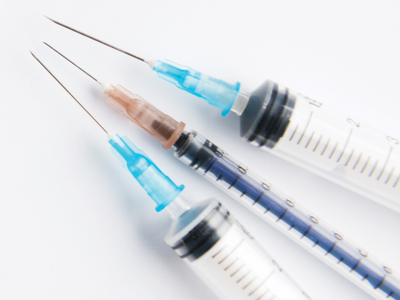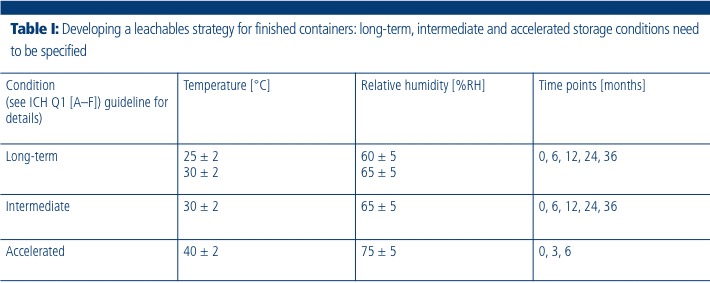The potential for harmful chemicals to be extracted from packaging materials that pose a risk to patients has spurred regulatory authorities to establish guidelines for extractable and leachable (E&L) testing for primary drug packaging materials.1–3 Drug licence holders must establish programmes that effectively assess and test these contamination risks. In 1999, following the introduction of the asthma drug salmeterol in the UK, three cases of respiratory arrest occurred shortly after patients started taking the drug; and, at about the same time, the United Kingdom Committee on the Safety of Medicines reported 26 cases of deterioration in asthma soon after the introduction of long-acting beta-agonists. In 2005, a paper published in the medical journal Kidney International reported on the increased incidence of pure red cell aplasia with an Eprex formulation in uncoated rubber stopper syringes.
Recently, other issues have been highlighted in the media, such as concerns regarding the safety of phthalates, and there were reports of a postponement of the MMR vaccination of babies in some parts of the Netherlands because of fears about glue leaking from needles. The regulatory authorities have not been slow to react to these concerns and the very real risks of product contamination from E&Ls, the US having enacted E&L legislation under the Federal, Food, Drug & Cosmetic Act (FFDCA), and the EU having recently introduced decentralised and mutual recognition procedures for the evaluation of E&L safety risks.
The legal position
FFDCA, 21 CFR Part 211.94, states the following:- drug product containers and closures shall not be reactive, additive or absorptive so as to alter the safety, identity, strength, quality or purity of the drug beyond the official or established requirements
- container closure systems shall provide adequate protection against foreseeable external factors in storage and use that can cause deterioration or contamination of the drug product
- drug product containers and closures shall be clean and, when indicated by the nature of the drug, sterilised and processed to remove pyrogenic properties to ensure that they are suitable for their intended use; such depyrogenation processes shall be validated
- standards or specifications, methods of testing and, when indicated, methods of cleaning, sterilising and processing to remove pyrogenic properties shall be written and followed for drug product containers and closures.
Compendial standards are now the law, with 21 USC 351 stating that “the Secretary shall promulgate regulations prescribing appropriate tests or methods of assay in accordance with which such determination as to strength, quality or purity shall be made.”
There is no shortage of guidance for industry regarding the selection of appropriate materials for pharmaceutical packaging or for testing the stability of new drug substances, and products and a range of E&L test procedures have been developed to ensure patient (and public) safety. However, it is essential that both pharmaceutical/medical product and pharmaceutical/medical packaging companies know which compendial standards and guidances apply to their particular products and, if they do not know or are unsure, that they ask the relevant regulatory authority for advice.
Assays: best practice
What makes a good assay? The guiding principles are that testing procedures must be scientifically rigorous, be based on best practice by incorporating risk assessment and risk management principles, and that biological and chemical assessments complement and inform each other. Test regulations, procedures and standards need to be in alignment with other international standards and best practices, while due consideration must be given regarding the use of laboratory animals when selecting appropriate procedures.
According to ISO 10993-18, chemical characterisation is “the identification of a material and the identification and quantification of the chemicals present in materials or finished medical devices.” USP <1663> presents a framework for the design, justification and execution of an extractables assessment for pharmaceutical packaging and delivery systems, while also establishing the critical dimensions of an extractables assessment and discussing the practical and technical aspects of each dimension. However, the standard does not establish specific extraction conditions, analytical procedures or mandatory extractables specifications, nor acceptance criteria for particular packaging and delivery systems or drug products. Neither does it delineate every situation in which an extractables assessment is required.
Chemical characterisation can, therefore, provide an understanding of materials, components or a system, and assist with risk assessment. It also enables failure analysis to support a scientifically sound rationale for a failed biocompatibility test while advancing the so called 3Rs initiative (replacement, reduction and refinement) to reduce unnecessary in vivo testing. Prior to biocompatibility testing, the judicious application of chemical characterisation may provide information permitting the pre-emptive toxicological evaluation of chemical entities that may be irritants or sensitisers, or that may elicit an acute toxicity response. However, such procedures may not unequivocally declare the absence of such entities, and do not preclude a comprehensive evaluation of all available data to permit a risk-based-testing approach.
Determination of risk factors
The risk factors associated with extractables and leachables include general quality considerations associated with leachables, such as the pharmaceutical product’s stability and the possible formation of aggregates, their interference with analytical methods or diagnostic tests, and reduced process performance and associated medical effects. These include cell culture growth, the rate of drug release, drug solubility and drug efficacy. There is also the possibility that the leachable may be toxic and pose a health risk to the consumer.
The first requirement before doing any E&L testing procedure is to collect information from packaging suppliers regarding the possible medical effects of their products. The construction materials should be resistant against chemical attack, UV light, moisture, temperature and e-beam or gamma irradiation (through a sterilisation procedure) to avoid the altering of a material’s chemical profile or its physicochemical properties.
There are cases in which the contact materials have not shown compatibility whilst in contact with a drug product. An example is a case when a non-coated rubber stopper was incompatible with a drug formula, and calcium phosphate crystals were observed in a finished drug. The root cause of this was found to be precipitation of the phosphate following the leaching of calcium ions from the stopper. Calcium stearate is used by the rubber and plastic industries as an effective elastomer, processing aid and release agent, which may have been the source of the leaching calcium ions that then reacted.

Needles can pose a risk to patients if harmful chemicals are extracted from the packaging during use. In the Netherlands, the fear of glue leaking from needles postponed the MMR vaccination of babies.
Another potential cause of drug contamination is the photo- or gamma-induced degradation of cyclo-organic copolymers, which are often used in primary packaging such as in blisters for solid drugs, or in packaging for injectables. Possible mechanisms of degradation include oxidation, cracking and structural rearrangement.
When performing extractables testing for finished packaging, it is important to select appropriate extraction conditions and employ suitable analytical methods. Nevertheless, no specific guidelines exist regarding the suitability of analytical screening methods for extractables in conjunction with plastic components.
The methods cannot be properly validated owing to the fact that the target analytes are not known. There is therefore a need to adopt a broad screening strategy to demonstrate the presence or absence of residues for subsequent quantitative efforts. The analytes of interest must be extracted from the materials and then subsequently identified, semi-quantified and then characterised using multiple analytical techniques.
Standard extractable protocols do not take into account the different chemical nature of polymers or laminated materials. The qualitative analysis of extractable analytes should be guided by an analytical evaluation threshold that must be correlated with the sensitivity of the analytical methods. Controlled extraction studies need to be done using different solvents to establish “worst case” conditions that maximise extraction, or to bracket use conditions under exaggerated conditions. The focus should be on the identification and calculation of the amount of extractables in the packaging or closure device. This is necessary to ensure the quality and comparability of the analytical results generated by laboratories for compliance purposes, and for the creation of data for risk assessment purposes. This should be achieved by using quality assurance systems and, specifically, by applying methods that have been qualified according to common procedures, that meet defined performance criteria and by ensuring traceability to common — or commonly agreed — standards.
Leachables are detected through the qualitative analysis of either freshly prepared product or product taken from real-time or accelerated storage programmes, with quantitation determined above an acceptable safety threshold. The determination of the limits of quantitation and the resultant typical chromatograms obtained for known targets provide the means of validating the test methods used.
These tests should also identify and quantify unforeseen leached substances above a safety limit for unknown contaminants, and the root cause of the leaching, with the test report tabulating levels of leachables seen from several shelf-life batches of the drug product or medical device.
Analytical sensitivity
It is essential to choose realistic extraction conditions that provide analytical sensitivity. Thus, solvent volumes must be correlated with the analytical evaluation threshold (AET) and the limit of quantitation (LOQ) of the analytical method using Equation 1 to provide the required sensitivity.

Equation 1: AET = the allowable amount/substance to be released representing the actual analytical evaluation threshold, ExVol = the volume of extraction solvent, factor = the concentration factor to adjust method sensitivity and MS = the analytical sensitivity of the proposed method, with MS > LOQ
However, if the AET of the extractable for the chosen method is inappropriate or impractical to use, the sensitivity of the analytical method may be adjusted by using a sample concentration factor. It is important to avoid the risk that any sample preparation of extract solution might result in the loss of analytes, or the risk that high concentration factors could result in the accumulation of environmental impurities. In addition, blank values cannot be validated in screening methods for extractables with regard to a specific target substance.
The correct method is to analyse the extract both in its original state (without concentrating the analyte by sample preparation) and by introducing a concentration factor. The concentration factor should not exceed 5–10x, with the more concentrated extract possibly being produced by increasing the extracted mass while employing a constant volume of solvent. It may be necessary to find an alternative normative rationale to determine the extraction stoichiometry; this method is highlighted, for example, in ISO 10993-12.
Completeness of an assessment
According to USP <1663>, the completeness of an extractables assessment can only be judged against the overall goals of the assessment, and the generation of extracts should be accomplished with multiple solvents or extracting media with varying extracting power based on the known extracting power of the drug product vehicle. Multiple and complementary extraction techniques need to be employed, including those with the capability for volatiles analysis, as do extraction conditions that allow equilibrium to be achieved.
In the E&L test extraction procedure for finished containers, 3–4 various solvents should be used to mimic real-use conditions. It is also important to choose the appropriate tools for separation and detection — volatile organics being evaluated using gas chromatography (GC) and semi-volatile organics being measured by liquid injection GC using a flame ionisation detector (FID) and a mass spectrometer (MS) detector with accurate mass assignments for fingerprinting. Non-volatile organics can be assessed by HPLC combined with diode-array detection (DAD) and a high resolution MS, whereas typical methods for elemental analysis include inductively coupled plasma mass spectrometry (ICP-MS) and inductively coupled plasma atomic emission spectroscopy (ICP-OES).
Cationic and anionic targets are evaluated using ion chromatography techniques. Specialist techniques may have to be employed for critical compounds, such as GC-thermal energy analysis (GC-TEA) for nitrosamines from rubber, or LC-MS/MS for perfluorinated carboxylic acids, amides and sulphonamides that may be present in perfluorinated polymeric materials. Complementary or additional techniques that may be employed include NMR, infra-red and ultraviolet spectrometry.
Leachables strategies
For leachables, target analysis is completed by validation combined with analytical screening. Thus, all methods need to be validated and target analysis may be appropriate or reasonable to monitor the expected leachables when extractables/simulated use profiles undoubtedly represent an identified profile. However, when extractables/simulated use profiles show many “known unknowns,” target analysis may be combined with multiple analytical methods to also discover unexpected leachables and/or poorly identified leachables that are “subsets” of the extractables. Storage conditions and suggested points for leachables analysis are presented in Table I.

The US Food and Drug Administration expects three production lots to be tested, and USP <1663/1664> states: “Leachables studies may include accelerated storage conditions, but they cannot be limited to accelerated conditions and must include real-time assessment.”
A leachables strategy must establish a quantitative and qualitative correlation between profiles and demonstrate that compounds detected in the leachable studies were also present in the controlled extractables studies. It is also important to demonstrate that the levels of leachables obtained from studies are generally less than the levels of extractables obtained in the quantitative controlled extraction studies. This requirement emphasises why it is necessary to use multiple batches in extractable and leachable studies.
References
- FDA Guidance for industry, Container Closure Systems for Packaging Human Drugs and Biologics: www.fda.gov/downloads/drugs/ guidances/ucm070551.pdf (May 1999).
- FDA Guidance for Industry: Nasal Spray and Inhalation Solution, Suspension, and Spray Drug Products: www.fda.gov/downloads/drugs/ guidancecomplianceregulatoryinformation/ guidances/ucm070575.pdf (July 2002).
- EMEA Guideline on Plastic Immediate Packaging Materials (CPMP/QWP/4359/03): www.ema.europa.eu/docs/ en_GB/document_library/Scientific_guideline/2009/09/WC500003448.pdf (May 2005).





